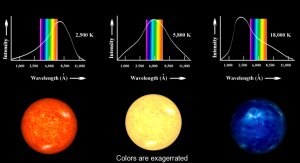

So how does light get produced? There are a number of different mechanisms for producing light. Ultimately, this is really important for understanding what we see. If we see some light coming from the sky, we want to know what it is coming from. So we need to know a little bit about ways in which one can make light.
A good starting point is something called a blackbody. Now, this is a theoretical construct. They don’t really exist. Although you can make something in a lab that’s close to a blackbody, you can never make a perfect blackbody. As I said, theoretical construct.

This is a theoretical construct where the emission of light coming out of this object just depends on its temperature. It’s called a “blackbody” because, amongst other things, it has to be a perfect absorber (meaning that it absorbs all wavelengths equally and perfectly). If the emission is independent of temperature, and you go through all the physics of it, it has to be a perfect absorber. It doesn’t reflect anything. And of course, perfect absorbers are black…obviously, since it absorbs all wavelengths equally and perfectly. However, blackbodies actually aren’t really black. This is a common mistake. People take the name “blackbody” to mean it *looks* black.
As I said, the defining thing of a blackbody is it’s a perfect absorber and its emission only depends on its temperature. Yet, if these perfect absorbers just kept on absorbing everything around them, they would get hotter and hotter and eventually they’d get infinitely hot. That doesn’t happen, even to these theoretical things. There are objects that are close to being blackbodies. In fact, a star isn’t a perfect blackbody, but it’s pretty close, because any photon that hits a star is absorbed completely and the emission from the star’s surface primarily depends on its temperature. But stars are not black; you see them. Moreover, stars are also not all the same colour. In the same way, blackbodies are not all the same colour. They just emit proportional to their temperature (and that is the key). The emission at each wavelength depends on the temperature again; everything just depends on the temperature. So a given area, say one square metre of surface area, its emission (if it’s a blackbody) just depends on its temperature.

So I’m not going to go into the equation that describes blackbody emission. But there are a few summary things. One is that the wavelength at which it’s the brightest –at which it emits the most– varies as one over the temperature. So that sounds complicated. Why would it do that? You already know this though, if you think about it. There are lots of objects that, while they’re not perfect blackbodies, they’re not bad as a blackbody. If you take a black or dark piece of wood and throw it into the fire and start burning it, the colour of the flame depends on the temperature. An even better example is iron. You have some black-looking iron and you heat it up. It starts out looking black. It’s cold. If you heat it up a bit, it starts to glow. Just as in a fireplace, if it gets hot the fireplace starts to glow kind of red. Well, the iron will glow red. If you heat it up some more, it starts to look orange. It’s hotter; it emits the light at a shorter wavelength. So the temperature increases, one over T decreases.
That means the wavelength at which the peak emission’s coming out is getting shorter. If you heated that piece of iron up more, it would start to look kind of white-hot. And if you were to really heat it up, which you could never really do because it would melt and vaporize (the iron would all go away) you could get into blue-hot. There is one way to get blue-hot things and that’s to take carbon and make that really hot. Carbon arc lights, you might have heard of, are a very blue light. They put out a lot of ultraviolet and can damage your eyes. You need to have special goggles to look at an arc lamp. This is the first property of blackbodies that comes directly from the fact that it is a perfect absorber and that it emits just proportional to wavelength. It turns out that if you crank through the physics, the peak varies as one over the temperature. The other thing is that the total amount of emission from a given area is proportional to the temperature to the 4th power.
So something is twice as hot. It doesn’t emit twice as much light for each square metre of surface. Instead, it emits 16 times as much light as something that’s half the temperature.